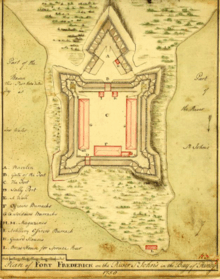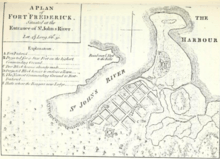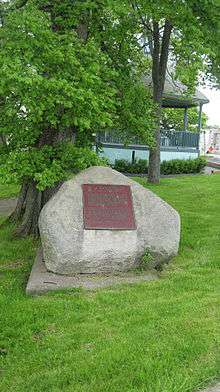Fort Frederick (Saint John, New Brunswick)


.jpg)

Fort Frederick was a British fort at what is now Saint John, New Brunswick, Canada. It was built during the St. John River Campaign of the French and Indian War. It was one of three significant forts which the British built on the major rivers in the Northeast to cut off the natives water way to the ocean (also see Fort Halifax and Fort Pownall).[1]
On September 13, 1758, Robert Monckton and a strong force of regulars and rangers (Gorham's Rangers, Danks' Rangers and Rogers' Rangers) left Halifax, and arrived at the mouth of the St. John River a week later. He established a new base of operations by reconstructing Fort Menagoueche, which had been destroyed in 1755, and which he renamed Fort Frederick.[2] Establishing Fort Frederick allowed the British to virtually cut off the communications and supplies to the villages on the St. John River.[3] (Fort Frederick (Maine) was decommissioned the following year.)
Commanders
- Major Roger Morris
- Lt Col Arbuthnot
- Lt Tong
- Ensign Jeremiah Mears
See also
References
- ↑ https://archive.org/stream/acg3054.0001.005.umich.edu#page/364/mode/2up
- ↑ Roger Sarty and Doug Knight. Saint John Fortifications. 2003. p. 31; John Grenier. The Far Reaches of Empire: War in Nova Scotia, 1710-1760. Oklahoma University Press.pp. 199-200; F. Thériault, p. 11
- ↑ Plank, p. 68
Primary sources
Secondary sources
- Campbell, Gary. The Road to Canada: The Grand Communications Route from Saint John to Quebec. Goose Lane Editions and the New Brunswick Military Heritage Project. 2005
- Faragher, John. A Great and Nobel Scheme. Norton. 2005. p. 405.
- Grenier, John. The Far Reaches of Empire: War in Nova Scotia, 1710-1760. Oklahoma University Press.pp. 199–200
- Macfarlane, W. G. Fredericton History; Two Centuries of Romance, War, Privation and Struggle, 1981
- Maxwell, L.M.B. An Outline of the History of Central New Brunswick to the Time of Confederation, 1937. (Republish in 1984 by the York-Sunbury Historical Society.)
- Patterson, Stephen E. 1744-1763: Colonial Wars and Aboriginal Peoples. In Phillip Buckner and John Reid (eds.) The Atlantic Region to Conderation: A History. Toronto: University of Toronto Press. 1994. pp.125-155
- Plank, Geoffrey. "New England Soldiers in the Saint John River Valley: 1758-1760" in New England and the Maritime provinces: connections and comparisons By Stephen Hornsby, John G. Reid. McGill-Queen's University Press. 2005. pp. 59–73
- Raymond, William O. The River St. John: Its Physical Features, Legends and History from 1604 to 1784. St. John, New Brunswick. 1910. pp. 96–107
- Thériault, Fidèle. Le village acadien de la Pointe-Sainte-Anne (Fredericton),
- George MacBeath, “GODIN, Bellefontaine, Beauséjour, JOSEPH,” in Dictionary of Canadian Biography, vol. 4, University of Toronto/Université Laval, 2003–,
- AD, Calvados (Caen), C 1020, mémoire de Joseph Bellefontaine, dit Beauséjour, 15 janv. 1774
- Placide Gaudet, “Acadian genealogy and notes,” PAC Report, 1905, II, pt.Template:Iii, 140, 241. N.S. Archives, III
- Joseph Rôbinau de Villebon, Acadia at the end of the seventeenth century; letters, journals and memoirs of Joseph Robineau de Villebon...J. C. Webster, édit. (Saint-Jean, N.-B., 1934), 99, 149, 154.— L.